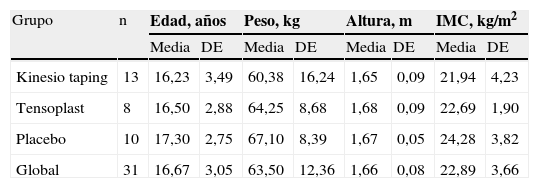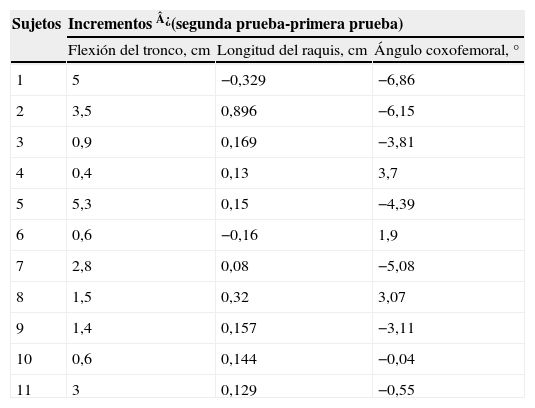Analizar si la aplicación del kinesio taping consigue un incremento en la flexión del tronco en comparación con la aplicación de vendas placebo y vendas adhesivas convencionales. Estudiar en qué segmentos se consigue este posible incremento.
Material y métodosEstudio experimental a doble ciego. Los treinta y tres sujetos participantes fueron distribuidos aleatoriamente en tres grupos: a) aplicación del kinesio taping; b) aplicación de vendas convencionales, y c) grupo placebo. Se valoró la flexión del tronco de todos los sujetos mediante la prueba sit-and-reach antes y después de la intervención siguiendo un protocolo idéntico. Posteriormente, se analizó el incremento en la flexión del tronco de los sujetos del grupo kinesio taping mediante el software e-Ruler®.
ResultadosLa media de incremento de la flexión del tronco de los sujetos del grupo kinesio taping es superior a la de los otros grupos, pero la diferencia no es estadísticamente significativa (análisis de la variancia, p=0,67). Todos los sujetos del grupo kinesio taping incrementan su flexión del tronco, mientras que en los otros dos grupos la proporción es de un 77%; sin embargo, este resultado no alcanza significación estadística (Chi cuadrado p=0,06). Existe correlación entre el incremento conseguido en el grupo kinesio taping y el decremento del ángulo coxofemoral (r=−0,712; p<0,05).
ConclusionesNo se ha podido demostrar que la aplicación del kinesio taping incremente la flexión del tronco. La ganancia conseguida se relaciona más con el decremento del ángulo coxofemoral que con una mayor extensibilidad del raquis.
This study has aimed to analyze whether the application of Kinesio taping increases trunk flexion compared with the application of placebo bandages and conventional adhesive bandages and to study in which segments this possible increase occurs.
Materials and methodsExperimental, double-blind study. The 33 subjects were randomly distributed into three groups: Kinesio taping was used in group A, conventional bandages in group B, and placebo bandages in group C. An identical protocol was followed, evaluating trunk flexion in all of the subjects with the set-and-reach test before and after the treatment. The software e-Ruler® was then used to evaluate increase in trunk flexion in the Kinesio taping group.
ResultsThe average increase in trunk flexion in the Kinesio taping group was greater than that of the other groups. However, the difference was not statistically significant (ANOVA, p=0.67). Trunk flexion increased in all the subjects in the Kinesio taping group whereas it increased in 77% of the subjects in the other two groups. However, this result is not statistically significant (Chi square p=0.06). A correlation was found between the increase in the Kinesio taping group and the decrease in the coxofemoral angle (r=−0.712; p<0.05).
ConclusionsIt could not be demonstrated that the application of Kinesio taping increases trunk flexion. The gain achieved is more closely related to the decrease in the coxofemoral angle than to the greater extensibility of the rachis.
Article
Si ya tiene sus datos de acceso, clique aquí.
Si olvidó su clave de acceso puede recuperarla clicando aquí y seleccionando la opción "He olvidado mi contraseña".















